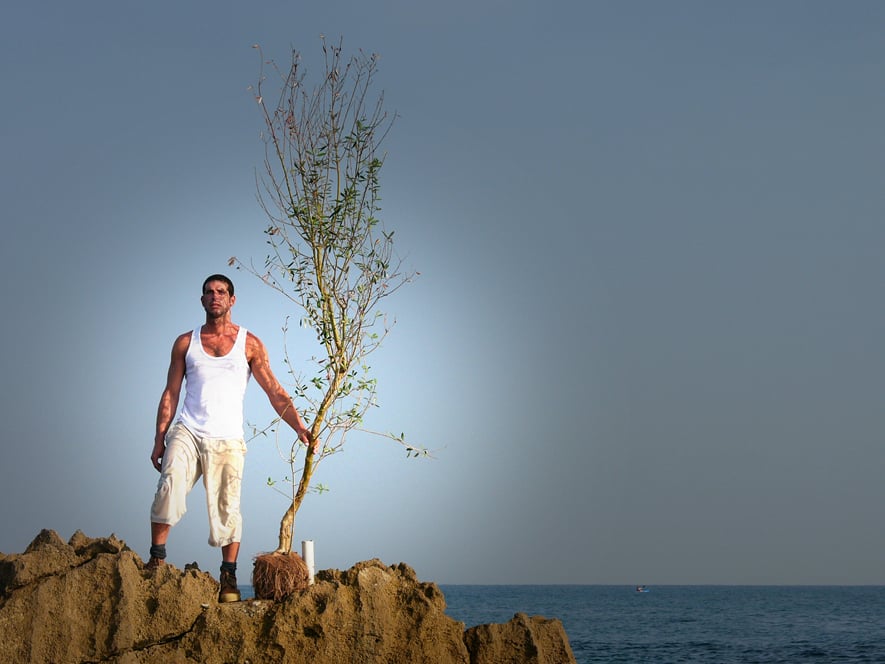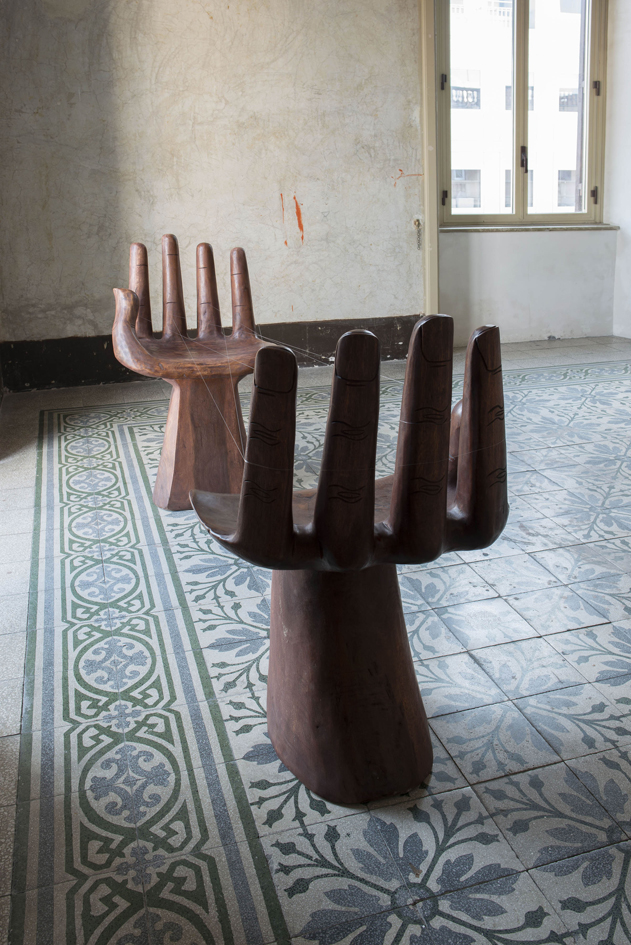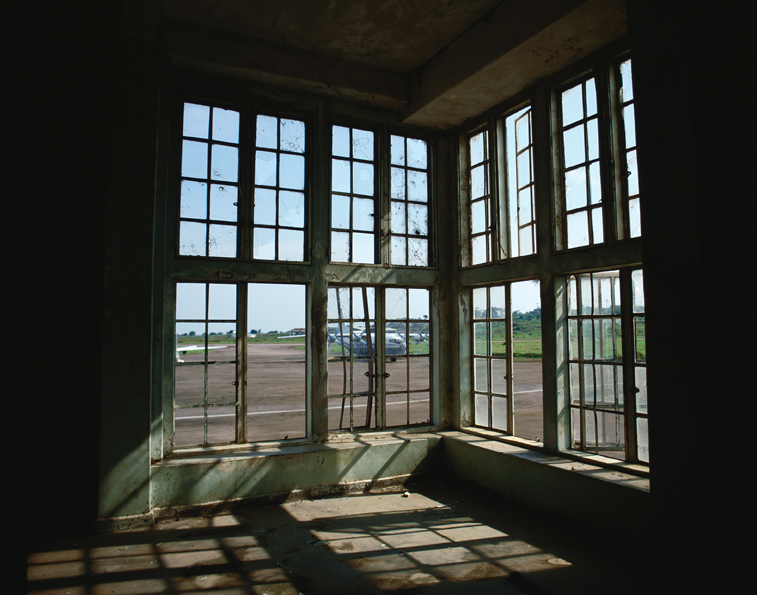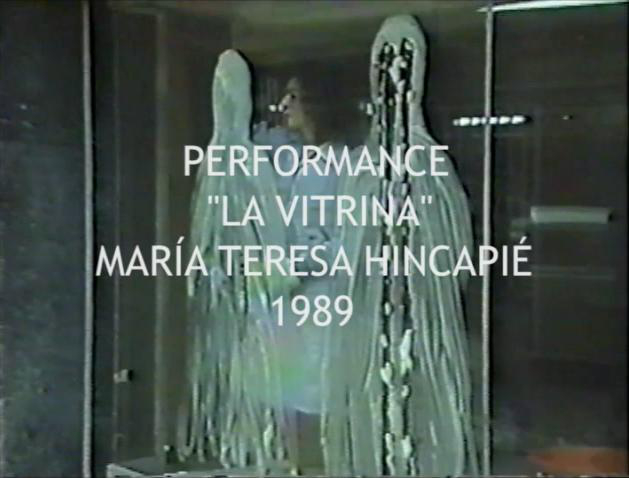
© » KADIST
Mariana Castillo Deball
Mariana Castillo Deball’s set of kill hole plates are part of a larger body of work problematizing archeological narratives, and drawing attention to the conservation process and its role in recreating an imagined object. They are playful and exaggerated representations of “kill hole pottery” — ceramic dishes in the Mimbres tradition with distinct circular holes located in the center of the pots. Although very little is known about the Mimbres culture’s specific beliefs, they are loosely understood to have terminated the object symbolically in preparation for funerary use.

© » KADIST
Mariana Castillo Deball
Do ut des (2009) is part of an ongoing series of books that Castillo Deball has altered with perforations, starting from the front page and working inward, forming symmetrical patterns when each spread is opened. The books belong to O Mundo dos Museus (The World of Museums), a collection conceived by the Brazilian designer Eugênio Hirsch in the 1970s. More than simply a catalogue of artworks, each offers the reader a promenade through a different world museum and its functioning, starting with photo reportage of the building, its urban landscape and architecture, the management and restoration of works, and visitors walking though the galleries.

© » KADIST
Mariana Castillo Deball
Taking archaeology as her departure point to examine the trajectories of replicated and displaced objects, “Who will measure the space, who will tell me the time?” was produced in Oaxaca for her exhibition of the same title at the Contemporary Museum of Oaxaca (MACO) in 2015. The sculpture, employing the technique of traditional Atzompa pottery originating from Oaxaca, Mexico, is an examination of the way in which archaeological heritage is remembered in the earthenware made by Atzompa potters today. Accompanied by the publication ‘Ixiptla Vol.

© » KADIST
Marina Rosenfeld
The installation Music Stands: Free Exercise 7, 8, and 9 by Marina Rosenfeld consists of music stand-like structures and a corresponding set of panels and acoustic devices that direct, focus, obstruct, reflect and project sound in the gallery. Together the components play on the connection between aural and social relations signified by the music stands. An episodic score emanates from the work’s sound system, momentarily interrupting the atmosphere with brief eruptions of electronic sounds and vocality.

© » KADIST
Yael Bartana
Yael Bartana’s video work A Declaration was shot in southern Tel Aviv, on the visible border between that city and Jaffa. It begins with the sound of waves and the image of the Israeli flag that fills the entire screen. This is followed by the whirring sounds of a helicopter.

© » KADIST
Adriana Lara
Lara uses things readily at hand to create objects and situations that interrogate the processes of art and the spectrum of roles that art and artists play in society. To these ends, she has used furniture, projections, photographs, clothing, and even people as her materials. A reflection on how the production of meaning itself takes place in the manufacturing of things is embodied in wooden hand chairs, a crafty Indonesian version of the iconic Pedro Friedeberg 1960s Pop design.

© » KADIST
Adriana Martínez
Her work Al final del arcoiris (At the end of the rainbow, 2015) is a bundle of bills from Chile, Venezuela, Brazil, Colombia, Nicaragua, and Costa Rica, arranged by color to form a tight spiraling rainbow held close with a rubber band. Here, Martinez uses these various currencies to gesture towards questions of capital and value, the accumulation of wealth, and regional economies. Beneath the surface of her playful visual propositions, Martinez asks us to consider not only the monetary costs of international goods, but also the real, human consequences of a global economic culture that privileges some and devastates others.

© » KADIST
Marwan Rechmaoui
Drawing & Print (Drawing & Print)
Throughout his career, Marwan Rechmaoui has maintained a drawing practice. During the Covid-19 pandemic lockdowns the artist spent his evenings recording thoughts and imagery on paper, inspired by events happening around him, music, his garden, and the news. These drawings are contemporaneous in their concerns and are indexical of a destitute time and space in the aesthetics they conjure.

© » KADIST
Marwan Rechmaoui
Drawing & Print (Drawing & Print)
Throughout his career, Marwan Rechmaoui has maintained a drawing practice. During the Covid-19 pandemic lockdowns the artist spent his evenings recording thoughts and imagery on paper, inspired by events happening around him, music, his garden, and the news. These drawings are contemporaneous in their concerns and are indexical of a destitute time and space in the aesthetics they conjure.

© » KADIST
Yael Bartana
Yael Bartana received great international attention for the trilogy series And Europe Will be Stunned (2007 – 2011). The series, which includes the films Mary Koszmary (Nightmare) (2007) , Mur i wieza (Wall and Tower) (2009), and Zamach (Assassination) (2011), centers on a young Polish politician’s call for the return of 3.3 million Jewish people who emigrated to Palestine. The films employ the same techniques of Leni Riefenstahl’s Nazi propaganda films, combining fact and fiction with the past and the present.

© » KADIST
Adriana Martínez
Her 2015 work Orión is a black flag-like cloth with glow-in-the-dark symbols embroidered in the shape of the constellation. In the place of stars, Martínez has substituted the logos of international corporations and entities that use stars as their symbol; celestial navigation commanded by the logic of international corporations. Easily spotted is the smiling face of the Carl’s Jr. / Hardee’s logo, the three-pronged Mercedes-Benz emblem, Walmart’s six-pointed asterisk, and the starry cluster of the Subaru shield.

© » KADIST
Adriana Bustos
El mar y sus múltiples afluentes (The Sea and its Multiple Tributaries) builds on the concept of trafficking that Adriana Bustos has been exploring over the last decade. The piece represents an apocryphal river and illustrates the routes of the slave trade between the coasts of Africa, Europe, and South America, departing from the Congo River (once called Zaira), and arriving at Río de la Plata, the main river in Buenos Aires that divides Argentina from Uruguay. The work collapses time and space, placing the coasts of colonial empires across the colonies where slaves were taken.

© » KADIST
Aline Baiana
Indigenous educator and curator Sandra Benites, of the Guarani-Ñandeva people, narrates the origin myth of the bird Urutau in her native language. This nightjar stands still on a branch all day long and, at dusk, cries a low hoot resembling a human weeping. In 2013, indigenous activist José Urutau Guajajara remained on the top of a tree for 26 hours, deprived of food and water by state forces.

© » KADIST
Zarina Bhimji
Born in Uganda of Indian descent, Bhimji has lived in London after her family sought refuge from the regime of Idi Amin who compulsorily expelled all Asians from Uganda. Her recent work has been concerned with revisiting the country of her childhood and engaging with the experience of exile, political and social destruction, and deprivation. This photograph, which belongs to the series “Love”, was shot by Bhimji during her journey in Uganda in 2001, but was only edited in 2006.

© » KADIST
Maria Taniguchi
Untitled (Celestial Motors) is a visual meditation on an icon of modern urban Philippine life—the jeepney. This ubiquitous form of public transportation, originally built from U. S. military jeeps left on the islands after World War II, is normally exuberantly painted and personalized. They are known for their crowded seating and kitsch decorations, which have become an omnipresent symbol of Philippine culture.

© » KADIST
Maria Bussman
Drawing & Print (Drawing & Print)
The drawing “Heidegger’s Cabin” (2005) is inspired by Martin Heidegger’s essay, “The Origin of the Work of Art.” During the artist’s stay in a high alpine area, near a lake reservoir, Bussmann related the landscape in her surroundings to her reading of Heidegger’s terms on the work of art and the meaning of a “thing.” In attempt to link spiritual heights to natural heights, Bussmann metaphorically relates the subjects of being and truth to a hiking path, and its different degrees of challenge and risk. In the drawings rather than finding the optimal path to reach ultimate meaning and materialization, Bussmann never arrives at “Heidegger’s Cabin,” and instead is led off the beaten track to areas she never discovered before. Upon her return from the mountains in 2004 and 2005, she continued to develop the series, leading up to 20 drawings on handmade paper that attempt to problematize Heidegger’s theory on artworks as “things” as bearers of traits, “things” confronting the world of perception, and “things” as formed matter.

© » KADIST
Maria Taniguchi
Maria Taniguchi works across several media but is principally known for her long-running series of quasi-abstract paintings featuring a stylized brick wall device. Full of subtle gradations and low-key modulations, these are her trademark: a sustained, reiterative practice, steeped in repetition but carefully attuned to the economies and the sculptural presence of painting. Her approach to painting is conceptual.

© » KADIST
María Buenaventura
The Territory is not for sale is a process of reflection and research with people, thinkers and community leaders from Usme, a rural part of Bogotá on the tenuous verge of becoming urban. As an art object and installation, it comprises multiple stacks of paper each containing the decrees of land expropriation from many different peasant farmers who are being forced to sell their lots of land back to the government. Usme lies at the southern urban-rural border strategically located next to the Páramo de Sumapaz, an enormous neo-tropical tundra ecosystem and water reserve.

© » KADIST
Marion Scemama, David Wojnarowicz
Political artist, painter, writer, performer, photographer, David Wojnarowicz, who died of AIDS in 1992 in New York City, was one of the leading figures of the New York Downtown artistic scene of the 80s. His use of image, language and collage generated a new method of idea communication. The series of five videos Collaborative Film Collection made in collaboration with Marion Scemama in 1989 is emblematic of his artistic practice, it unfolds through performance, films, photographs, texts and paintings.

© » KADIST
Marion Scemama, David Wojnarowicz
Political artist, painter, writer, performer, photographer, David Wojnarowicz, was one of the leading figures of the New York Downtown artistic scene of the 1980s. His use of image, language and collage generated a new method of idea communication. The series of five videos Collaborative Film Collection made in collaboration with Marion Scemama in 1989 is emblematic of his artistic practice, it unfolds through performance, films, photographs, texts and paintings.

© » KADIST
Marion Scemama, David Wojnarowicz
Political artist, painter, writer, performer, photographer, David Wojnarowicz, who died of AIDS in 1992 in New York City, was one of the leading figures of the New York Downtown artistic scene of the 80s. His use of image, language and collage generated a new method of idea communication. The series of five videos Collaborative Film Collection made in collaboration with Marion Scemama in 1989 is emblematic of his artistic practice, it unfolds through performance, films, photographs, texts and paintings.

© » KADIST
Marion Scemama, David Wojnarowicz
Political artist, painter, writer, performer, photographer, David Wojnarowicz, who died of AIDS in 1992 in New York City, was one of the leading figures of the New York Downtown artistic scene of the 80s. His use of image, language and collage generated a new method of idea communication. The series of five videos Collaborative Film Collection made in collaboration with Marion Scemama in 1989 is emblematic of his artistic practice, it unfolds through performance, films, photographs, texts and paintings.

© » KADIST
Marion Scemama, David Wojnarowicz
Political artist, painter, writer, performer, photographer, David Wojnarowicz, who died of AIDS in 1992 in New York City, was one of the leading figures of the New York Downtown artistic scene of the 80s. His use of image, language and collage generated a new method of idea communication. The series of five videos Collaborative Film Collection made in collaboration with Marion Scemama in 1989 is emblematic of his artistic practice, it unfolds through performance, films, photographs, texts and paintings.
![Elevación [Elevation]](https://kadist.org/wp-content/uploads/2022/09/IMG_escena001_3513-scaled.jpg)
© » KADIST
Ana María Millán
Interested in role-play and videogames, Ana María Millán developed workshops with different communities in order to create characters and scenarios for her animations, often in collaboration with a choreographer. Elevación evokes various narratives inspired by the comicstrip Marquetalia, Raíces de la Resistencia (Marquetalia, Roots of the Resistance) (2011). This comic strip is a memoir of the FARC (Revolutionary Armed Forces of Colombia) guerillas written by Jesús Santrich, one of its leaders who, after the 2016 Peace Agreement, rejoined dissident members of the organization in a clandestine guerrilla splinter group in 2019.

© » KADIST
María Isabel Rueda
The Real. Retrato de Norman Mejía. (The Real. A Portrait of Norman Mejía.)

© » KADIST
Maria Fernanda Plata
Unraveling, or “unweaving” sections of fabric, Maria Fernanda Plata arrived at delicate and tenuous-looking forms, both ghostly and gentle. Her careful meditations in fabric reflect Plata’s ongoing interest in the relationship between people and their environments, in fragility, systems, and destruction.

© » KADIST
María Teresa Hincapié
In the performance video Vitrina , María Teresa Hincapié stood inside a storefront window in downtown Bogota, unannounced, for eight hours a day, wearing a uniform and initially carrying out cleaning chores. As the day and passers went by, the routine became more playful: she would send kisses to bus drivers on the busy Avenida Jiménez who would return them, use the newspaper with which she was shining the glass to flirtatiously hide and engage with an improvised audience or draw the shape of her body with soap and a sponge. She would interrupt these chores to carry out other ‘feminine’ activities, like brushing her hair or applying make-up, only to return to frantically cleaning the transparent surface that separated her from the public.

© » KADIST
João Maria Gusmão and Pedro Paiva
The artist duo João Maria Gusmão and Pedro Paiva traveled to Japan for a month to make a series of short 16mm films, often shot in slow-motion. This film, shown in continuous loop, has a run-time of just under 3 minutes, and is presented without sound. It captures a traditional Shisa (combination of a dog and lion from Okinawan mythology) animated by an invisible person.
Marion Scemama, David Wojnarowicz
Marion Scemama is a French photographer and filmmaker...
Mariana Castillo Deball
- location: Amsterdam & Berlin
- year born: 1975
- gender: female
- nationality: Mexican
- home town: Mexico City, Mexico
Maria Taniguchi
Throughout her paintings, sculptures, and videos, Maria Taniguchi unpacks knowledge and experience—connecting material culture, technology, and natural evolution—and investigates space and time, along with social and historical contexts...
Yael Bartana
- location: ‘Afula, Yisra'el
- year born: 1970
- gender: female
- nationality: Israeli
Marwan Rechmaoui
- location: Bayrut, Al-Lubnan
- year born: 1964
- gender: male
- nationality: Lebanese
Aline Baiana
Aline Baiana’s work is informed by extensive theoretical and field research on indigenous, feminist, ethnic, environmental, and social justice matters...
Adriana Lara
Adriana Lara is fascinated by how a single thing (an object, a photograph, a song, a text) can be transformed into a work of art...
Maria Bussman
Maria Bussmann’s works represent an insistent attempt to fathom the epistemological quality of her medium, drawing...
Marina Rosenfeld
Marina Rosenfeld is a New York-based composer and artist working across disciplines...
Maria Fernanda Plata
Colombian artist Maria Fernanda Plata found herself drawn to fabric as a material with conceptual implications while on a residency in Vietnam...
Zarina Bhimji
- location: Mbarara, Uganda
- year born: 1963
- gender: female
- nationality: Ugandan
Adriana Bustos
Adriana Bustos creates a narrative discourse through installation, video, photography and drawing, in which her reflections on prevailing social, political or religious oppression appear in non-linear interpretations of history...
-
1980-1989
Marion Scemama, David Wojnarowicz
1989Political artist, painter, writer, performer, photographer, David Wojnarowicz, who died of AIDS in 1992 in New York City, was one of the leading figures of the New York Downtown artistic scene of the 80s...
Marion Scemama, David Wojnarowicz
1989Political artist, painter, writer, performer, photographer, David Wojnarowicz, was one of the leading figures of the New York Downtown artistic scene of the 1980s...
Marion Scemama, David Wojnarowicz
1989Political artist, painter, writer, performer, photographer, David Wojnarowicz, who died of AIDS in 1992 in New York City, was one of the leading figures of the New York Downtown artistic scene of the 80s...
Marion Scemama, David Wojnarowicz
1989Political artist, painter, writer, performer, photographer, David Wojnarowicz, who died of AIDS in 1992 in New York City, was one of the leading figures of the New York Downtown artistic scene of the 80s...
Marion Scemama, David Wojnarowicz
1989Political artist, painter, writer, performer, photographer, David Wojnarowicz, who died of AIDS in 1992 in New York City, was one of the leading figures of the New York Downtown artistic scene of the 80s...
María Teresa Hincapié
1989In the performance video Vitrina , María Teresa Hincapié stood inside a storefront window in downtown Bogota, unannounced, for eight hours a day, wearing a uniform and initially carrying out cleaning chores...
-
2000-2009
Zarina Bhimji
2001Born in Uganda of Indian descent, Bhimji has lived in London after her family sought refuge from the regime of Idi Amin who compulsorily expelled all Asians from Uganda...
Maria Bussman
Drawing & Print
2005(Drawing & Print) The drawing “Heidegger’s Cabin” (2005) is inspired by Martin Heidegger’s essay, “The Origin of the Work of Art.” During the artist’s stay in a high alpine area, near a lake reservoir, Bussmann related the landscape in her surroundings to her reading of Heidegger’s terms on the work of art and the meaning of a “thing.” In attempt to link spiritual heights to natural heights, Bussmann metaphorically relates the subjects of being and truth to a hiking path, and its different degrees of challenge and risk...
Yael Bartana
2006Yael Bartana’s video work A Declaration was shot in southern Tel Aviv, on the visible border between that city and Jaffa...
Yael Bartana
2007Yael Bartana received great international attention for the trilogy series And Europe Will be Stunned (2007 – 2011)...
Mariana Castillo Deball
2009Do ut des (2009) is part of an ongoing series of books that Castillo Deball has altered with perforations, starting from the front page and working inward, forming symmetrical patterns when each spread is opened...
-
2010-2019
María Buenaventura
2011The Territory is not for sale is a process of reflection and research with people, thinkers and community leaders from Usme, a rural part of Bogotá on the tenuous verge of becoming urban...
Maria Taniguchi
2012Untitled (Celestial Motors) is a visual meditation on an icon of modern urban Philippine life—the jeepney...
Adriana Lara
2014Lara uses things readily at hand to create objects and situations that interrogate the processes of art and the spectrum of roles that art and artists play in society...
Mariana Castillo Deball
2015Taking archaeology as her departure point to examine the trajectories of replicated and displaced objects, “Who will measure the space, who will tell me the time?” was produced in Oaxaca for her exhibition of the same title at the Contemporary Museum of Oaxaca (MACO) in 2015...
Adriana Martínez
2015Her work Al final del arcoiris (At the end of the rainbow, 2015) is a bundle of bills from Chile, Venezuela, Brazil, Colombia, Nicaragua, and Costa Rica, arranged by color to form a tight spiraling rainbow held close with a rubber band...
Adriana Martínez
2015Her 2015 work Orión is a black flag-like cloth with glow-in-the-dark symbols embroidered in the shape of the constellation...
Maria Taniguchi
2015Maria Taniguchi works across several media but is principally known for her long-running series of quasi-abstract paintings featuring a stylized brick wall device...
Maria Fernanda Plata
2015Unraveling, or “unweaving” sections of fabric, Maria Fernanda Plata arrived at delicate and tenuous-looking forms, both ghostly and gentle...
João Maria Gusmão and Pedro Paiva
2015The artist duo João Maria Gusmão and Pedro Paiva traveled to Japan for a month to make a series of short 16mm films, often shot in slow-motion...
Aline Baiana
2016Indigenous educator and curator Sandra Benites, of the Guarani-Ñandeva people, narrates the origin myth of the bird Urutau in her native language...
Adriana Bustos
2018El mar y sus múltiples afluentes (The Sea and its Multiple Tributaries) builds on the concept of trafficking that Adriana Bustos has been exploring over the last decade...
Marina Rosenfeld
2019The installation Music Stands: Free Exercise 7, 8, and 9 by Marina Rosenfeld consists of music stand-like structures and a corresponding set of panels and acoustic devices that direct, focus, obstruct, reflect and project sound in the gallery...
Ana María Millán
2019Interested in role-play and videogames, Ana María Millán developed workshops with different communities in order to create characters and scenarios for her animations, often in collaboration with a choreographer...
-
2020-2029
Marwan Rechmaoui
Drawing & Print
2021(Drawing & Print) Throughout his career, Marwan Rechmaoui has maintained a drawing practice...
Marwan Rechmaoui
Drawing & Print
2021(Drawing & Print) Throughout his career, Marwan Rechmaoui has maintained a drawing practice...